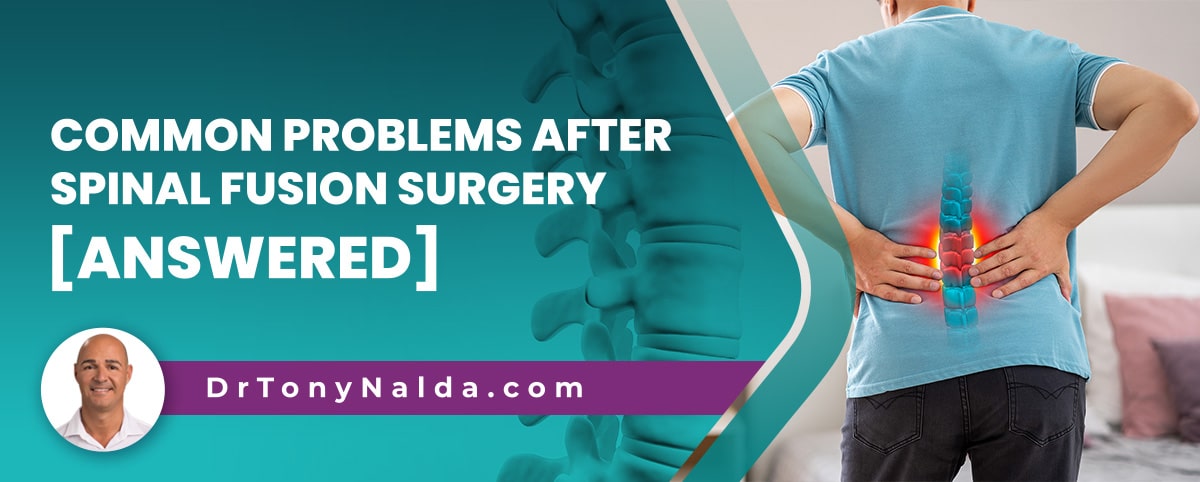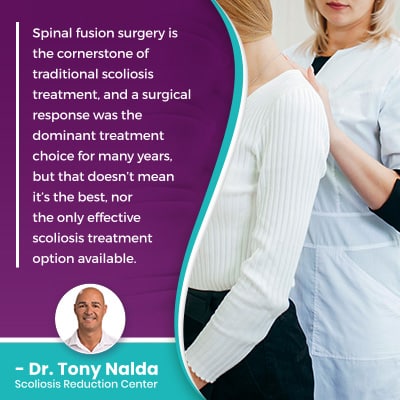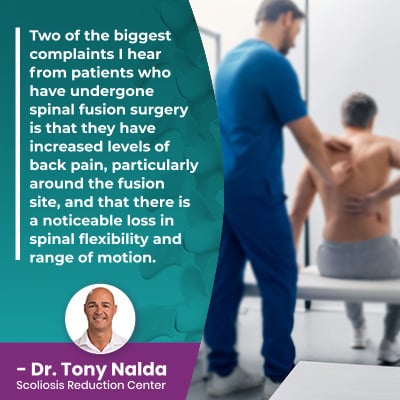Common Problems After Spinal Fusion Surgery [ANSWERED]

When it comes to treating scoliosis, as a progressive condition, how a diagnosis of scoliosis is responded to is key. Waiting to start treatment can mean passively allowing a condition to get worse, and progression only makes scoliosis more complex to treat.
Spinal fusion surgery is a traditional scoliosis treatment method that can cost the spine in terms of its overall health, strength, and function; conservative treatment offers patients a non-surgical treatment alternative that is less invasive and problematic.
Before getting to the specific problems some patients experience after spinal fusion surgery, let’s first address the complex nature of scoliosis.
Table of Contents
Understanding Scoliosis
Scoliosis is a structural spinal condition that is highly-prevalent and complex to treat.
Scoliosis is often described as a complex condition for a number of reasons, starting with how widely it ranges in severity from mild to moderate and severe to very severe.
In addition, there are multiple different types of scoliosis with different causes and treatment needs.
The majority of scoliosis cases are idiopathic, meaning not clearly associated with a single-known cause, and this account for 80-percent of known diagnosed cases, and the remaining 20 percent are associated with known causes: neuromuscular scoliosis, degenerative scoliosis, and congenital scoliosis.
An important piece of information is a patient’s Cobb angle measurement, and this is determined during X-ray.
As scoliosis is the development of an unnatural sideways spinal curve with rotation, certain vertebrae in the spine (bones) are unnaturally tilted, and this forces the spine out of alignment; the spine needs to maintain its natural curves and alignment in order to function optimally.
Based on X-ray imaging, lines are drawn from the tops and bottoms of the curve’s most-tilted vertebrae, at its apex, and the resulting angle is expressed in degrees.
A patient’s Cobb angle tells me how far out of alignment the spine is, and also tells me how severe a patient’s scoliosis is:
- Mild scoliosis: Cobb angle measurement of between 10 and 25 degrees
- Moderate scoliosis: Cobb angle measurement of between 25 and 40 degrees
- Severe scoliosis: Cobb angle measurement of 40+ degrees
- Very-severe scoliosis: Cobb angle measurement of 80+ degrees
Now, a key condition-characteristic, both in terms of patient-experience and treatment options, is that scoliosis is a progressive condition.
Scoliosis is Progressive
As a progressive condition, scoliosis has it in its nature to worsen over time, so where a scoliosis is at the time of diagnosis doesn’t mean that's where it will stay, especially without proactive treatment that works towards counteracting the condition’s progressive nature.
Scoliosis is virtually guaranteed to get worse at some point, and patient age is an important factor when it comes to potential rates of progression, and this is because the trigger for scoliosis getting worse is growth.
So scoliosis progressing means the size of the unnatural spinal curve is increasing, as are the condition’s uneven forces being introduced to the body, and their effects.
So if scoliosis is left untreated, this can amount to allowing the size of the unnatural spinal curve to increase unimpeded, especially in children who still have growth yet to go through.
Adolescent idiopathic scoliosis, diagnosed between the ages of 10 and 18, is the condition’s most-prevalent type, and this age group is at risk for rapid-phase progression due to the unpredictable and rapid growth spurts that characterize puberty.
Now, when it comes to how a condition is responded to with treatment, treatment plans are crafted around condition severity, so let’s talk about condition severity and a surgical treatment response.
Spinal Fusion Surgery
 Spinal fusion surgery is the cornerstone of traditional scoliosis treatment, and a surgical response was the dominant treatment choice for many years, but that doesn’t mean it’s the best, nor the only effective scoliosis treatment option available.
Spinal fusion surgery is the cornerstone of traditional scoliosis treatment, and a surgical response was the dominant treatment choice for many years, but that doesn’t mean it’s the best, nor the only effective scoliosis treatment option available.
Spinal fusion surgery has the goal of stopping progression and does so by fusing the condition’s most-tilted vertebrae into one solid bone and attaching rods to the spine with pedicle screws to hold it in place.
Now, this can work to straighten a scoliotic spine, but the way it does so, through invasive and artificial means, is contrary to the spine’s movement-based design and can disrupt the spine’s overall health, strength, and function.
When vertebral bodies are fused together, this can involve the removal of spinal discs that sit between adjacent vertebrae, and the discs of the spine give it structure, flexibility, cushioning to prevent friction during movement, and act as the spine’s shock absorbers.
So removing the spine’s intervertebral discs doesn't come without a price, and in addition to risks associated with the procedure itself, spinal fusion is also associated with some long-term effects that should be considered carefully.
Spinal Fusion Surgery Risks
Each patient will respond to spinal fusion surgery in their own way, just like no two cases of scoliosis are the same.
Factors that impact how a patient will respond to scoliosis surgery is patient age and overall health, condition type, severity, curvature location, and the number of vertebrae fused.
The more vertebrae that are fused, the more lengthy and invasive the procedure, and the more likely it is to cause noticeable problems and effects, both short and long term.
All surgical procedures come with their share of risks, but spinal surgery can carry some particularly serious potential risks, side effects, and complications.
Risks associated with the procedure itself include:
- Nerve damage
- Infection
- Excessive blood loss
- Adverse reaction to hardware used
Now, when it comes to problems following spinal fusion surgery, these fall more into the category of potential long-term effects.
Long-Term Effects of Spinal Fusion Surgery
 When we’re discussing problems after spinal fusion surgery, these involve the long-term effects of the procedure.
When we’re discussing problems after spinal fusion surgery, these involve the long-term effects of the procedure.
One of the biggest concerns I have about spinal fusion surgery is that because there is a gap in the research on the effects of living with a fused spine 20, 30, 40+ years down the road, we neither fully understand the longevity of hardware used and/or what it’s like to really age with a fused spine.
Two of the biggest complaints I hear from patients who have undergone spinal fusion surgery is that they have increased levels of back pain, particularly around the fusion site, and that there is a noticeable loss in spinal flexibility and range of motion.
Remember, as spinal fusion involves the fusing together of multiple vertebrae into one solid bone, while this can eliminate progression, it does so by eliminating movement in the area, meaning the bones can’t become more unnaturally tilted over time (progress).
If a portion of the spine is excessively rigid and immoveable, this can cause an increase in back pain, particularly as the spine’s surrounding muscles are also affected.
In addition, as a portion of the spine is fused, it can cause a significant loss in spinal flexibility and range of motion, and this is the most common problem associated with living with a fused spine; this can impact quality of life as certain activities can become difficult to perform.
A fused spine is also weaker and more vulnerable to injury, and the psychological effect that that knowledge can have on a patient is another potential long-term effect of spinal fusion that shouldn’t be discounted.
Conclusion
So when it comes to deciding whether or not to commit to a surgical or a non-surgical scoliosis treatment approach, patients need to be aware that many cases of scoliosis can be treated successfully without surgical intervention.
Patients also need to understand the potential risks they are taking in terms of long-term spinal health and function, so the procedure should be considered carefully.
Here at the Scoliosis Reduction Center, I offer patients a non-surgical scoliosis treatment alternative that integrates condition-specific chiropractic care, physical therapy, corrective bracing, and rehabilitation into customized treatment plans.
Those on the path of traditional treatment have little effort made to prevent progressing into the severe classification, and when/if a patient does, they are commonly funneled towards spinal fusion surgery; I remind patients that had proactive treatment been applied earlier in the condtiion’s progressive line, progressing into the severe classification can be avoided in many cases.
As some common long-term problems associated with spinal fusion surgery include a loss of spinal flexibility and range of motion, increased pain levels, and a spine that’s more vulnerable to injury, opting for a modern non-surgical treatment approach can help address the scoliosis while preserving as much of the spine’s natural strength and function as possible.
Dr. Tony Nalda
DOCTOR OF CHIROPRACTIC
After receiving an undergraduate degree in psychology and his Doctorate of Chiropractic from Life University, Dr. Nalda settled in Celebration, Florida and proceeded to build one of Central Florida’s most successful chiropractic clinics.
His experience with patients suffering from scoliosis, and the confusion and frustration they faced, led him to seek a specialty in scoliosis care. In 2006 he completed his Intensive Care Certification from CLEAR Institute, a leading scoliosis educational and certification center.
About Dr. Tony Nalda
 Ready to explore scoliosis treatment? Contact Us Now
Ready to explore scoliosis treatment? Contact Us Now





